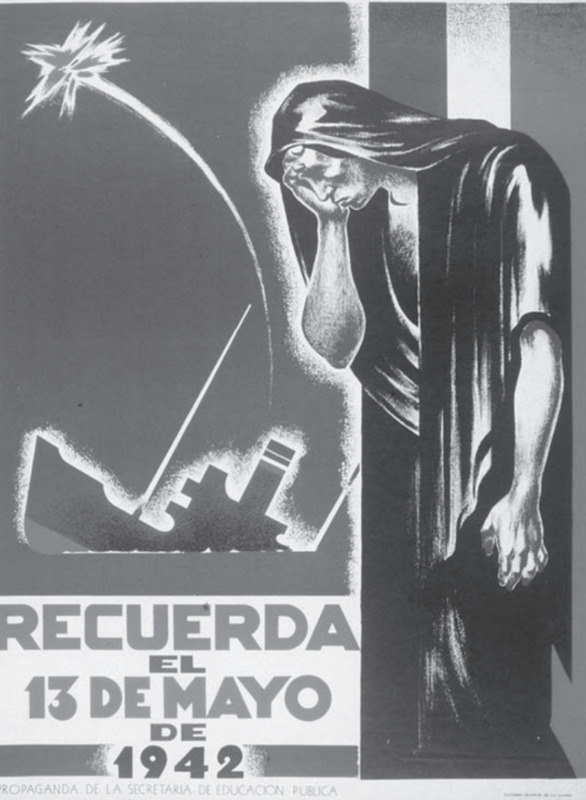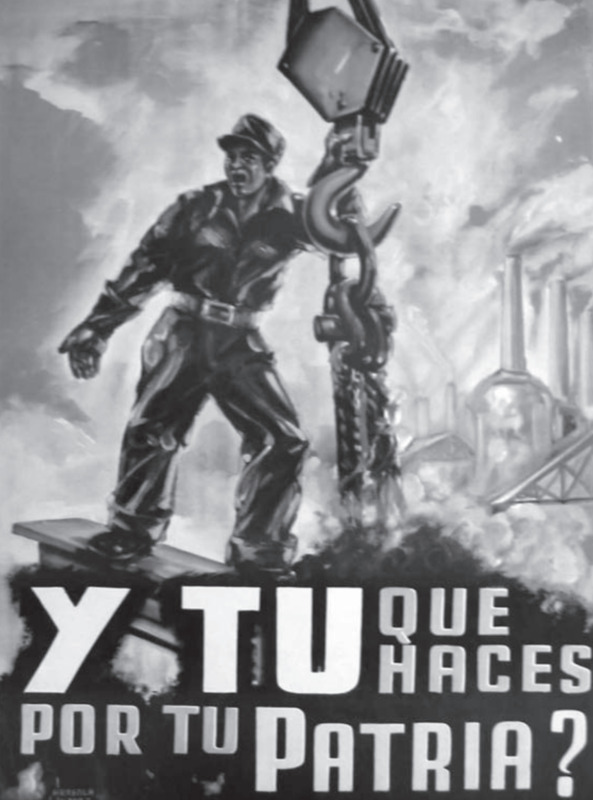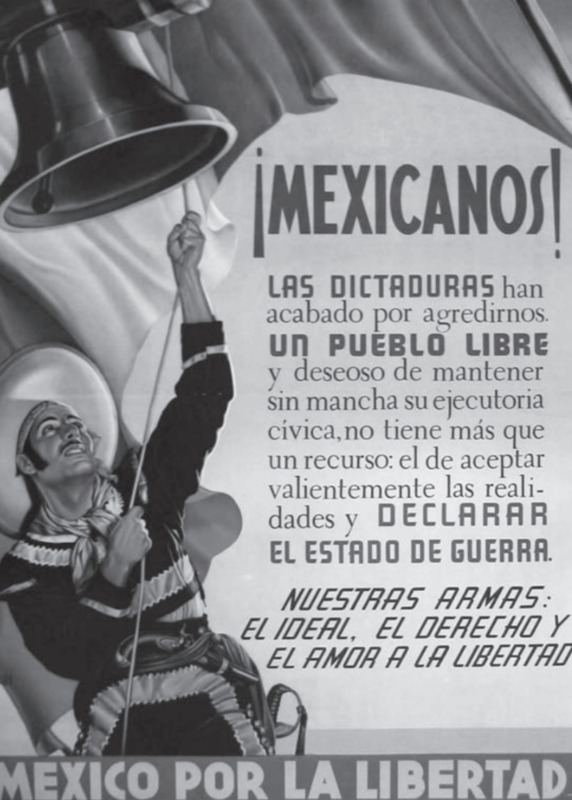The Federal Propaganda Office (OFP) and Mexican War Posters
After German submarines sank two Mexican tankers—the Potrero del Llano, on the night of May 13, 1942, and the Faja de Oro seven days later—a decree from the Congress of the Union on June 1, 1942, declared a state of war between Mexico and Germany, Italy, and Japan, as of May 22 that year (Gleizer 206). Mexico’s entry into WWII forced the closing of the borders to all non-American immigration. In reality, however, the doors were not closed to everyone. As the president’s private secretary explained to Indalecio Prieto: “the recent provisions dictated by the Government for controlling immigration into the country only affect those foreigners who Mexico considers undesirable, not those of Spanish nationality who may continue to come,” (González Gallo to Prieto, Mexico City, June 1942). Camacho’s designation of foreigners other than Spaniards as “undesirable” reveals the prevalence of Mestizaje within Mexican immigration policy well into his regime. Even as his country entered a state of war, this letter reveals that Camacho was still committed to fulfilling his national project. Meanwhile, throughout 1940 and 1941, the governments of the United States and Mexico moved closer together diplomatically as World War II encroached on the Western Hemisphere (Rankin 102).
Avila Camacho created a government propaganda agency specifically to disseminate wartime information and to win the support of Mexicans. Between May and August 1942 the government produced posters, pamphlets, and radio broadcasts to gain support for the war. The administration also began cooperating more closely with the OIAA in disseminating pro-Allied information through the press, radio, and film (Rankin 107). Support for Camacho was widespread, as between May and August 1942 a wave of patriotic support swept the country. Many feared the possibility of additional attacks, and a pervasive but short-term unity emerged as the public identified a common, external enemy. They identified themselves as Mexicans and as guardians of the democratic legacy of the revolution. They saw the Axis as the enemy of that legacy. Just as famous Mexican muralists had done in the 1920s, Mexicans in 1942 adopted a revolutionary national identity that conformed to their current circumstances. Meanwhile, the responsibilities of domestic wartime propaganda fell to the General Information Division of the Ministry of the Interior, led by José Altamirano. Altamirano established the Oficina Federal de Propaganda [Federal Propaganda Office] (OFP), which, according to historian Monica Rankin, outlined four basic approaches to winning public support for the war that we will see illustrated in the wartime posters they produced and disseminated.
First, the OFP appealed to national unity to rally Mexican support, calling for all factions to defend la patria and their freedoms. The office specifically targeted workers through federations and unions. It directed propaganda at campesino (farmer) groups, and universities and schools. The office specified professionals, writers, homemakers, religious organizations, the armed forces, and public and private workers as potential audiences for its propaganda. Second, the propaganda program involved encouraging a sense of sympathy and solidarity with the United States. Government officials understood that many Mexicans harbored resentment toward the United States. Recent memories of U.S. economic meddling and the recalcitrant behavior of oil companies in the wake of Cárdenas’s expropriation still influenced much of the country. Only two years earlier, anti-US sentiment had run rampant through the national press, and the government realized that those feelings of antipathy still existed. Altamirano argued that government propaganda needed to present the United States in a favorable light, as a mutual ally fighting for freedom and democracy in the world. He also decided that most of the OFP’s propaganda should avoid making close connections between Mexico and the United States in the context of the war. Instead, wartime propaganda should emphasize that Mexicans should support the war effort in the interest of protecting Mexico’s well-being. Most wartime information did not emphasize that Mexican involvement would benefit the United States in its war effort, but rather that Mexican patriotism would benefit la patria (Rankin 122).
Third, the strategy encouraged a strong work ethic in all citizens to maximize production. This part of Altamirano’s plan dovetailed with the incipient propaganda program that the government already had in place. To bolster its commercial agreements with the United States and to make those agreements benefit the national economy, Camacho’s administration needed the general public to support the war by working harder and producing more. Because Mexico’s primary role in the war was as a strategic producer, this theme quickly came to dominate government propaganda. Particularly throughout the summer of 1942, when patriotic enthusiasm encompassed much of the country, the government tried to capitalize on that zeal by urging high rates of industrial and agricultural output. It equated production with patriotism in its messages in an effort to convert nationalist energy into increased productive capacity (Rankin 122-3). Finally, Altamirano recommended promoting private initiative to encourage people to volunteer in any capacity that would help in the war effort. The Mexican government possessed limited resources for producing significant amounts of wartime propaganda. Altamirano understood that private initiative would strengthen the government’s wartime message (Rankin 123).
Camacho developed the Printed Propaganda Division to create and spread propaganda through newspapers, magazines, pamphlets, posters, comics, and corridos. It immediately began an aggressive graphic information campaign by printing large, colorful posters to spread the government’s war message (Fabela 83). Throughout 1942, government propaganda posters addressed two main themes: the German submarine attacks against Mexican ships, and the need to produce to contribute to the war effort (Fabela 83). First, the OFP explained Avila Camacho’s decision to declare war by reminding Mexicans of the submarine attacks. By keeping the attacks and the deaths of fellow countrymen fresh in public memory, the government hoped to encourage a patriotic response and instill loyalty to the Avila Camacho administration.
This poster, produced by the Mexican government in 1942 shows a female figure in mourning, with her head bowed and her hand to her face. In the background, a ship, already partially submerged, sinks from a torpedo attack. The caption reads, “Recuerda el 13 de mayo de 1942,” urging Mexicans not to forget May 13, 1942. The poster was printed in the three colors—red, white, and green—of the Mexican flag, promoting patriotic indignation (Fuentes 1987). The woman in the foreground is dressed in Catholic robes of mourning, appealing to Mexico’s tradition of presenting women as national care-takers, while simultaneously trying to evoke an emotional response. It is likely that by reminding Mexicans of the losses the country had suffered both in lives and in dignity at the hands of German aggressors, the government hoped to rally the population during the war. This centers the cause against Facism as pertaining directly to Mexico, and once again excludes people who are left out of the Mestizaje project.
This poster takes a different approach, emphasizing Mexico’s role as a supplier for Allied war materials. A factory worker stands atop a large steel beam being hoisted by a large chain and hook. He represents industrial workers as a silhouette of factory buildings and smokestacks rise in the distance. Below him the caption reads, “Y tú, que haces por tú patria? (And you, what are you making/doing for your country?). The verb “hacer” translates both as “making” and as “doing.” The poster’s designers chose the word deliberately to indicate that Mexicans should “do” something to contribute to the war effort by “making” products that were necessary for the war. This theme corresponds to the new economic and trade agreements with the United States that made Mexico a major supplier of Allied war materials. Government posters encouraged all Mexicans to work hard to produce those goods for the war effort. This poster therefore carefully crafts messages that tie worker productivity to good citizenship. The emphasis on “tu patria” reinforces that the country needs industrial and agricultural production, not only for the good of Allied powers, but also for the good of Mexico.
This poster approaches the declaration of war from the explicit perspective of Mexican traditions. A traditionally dressed man, complete with sombrero, cartridge belt, jacket, and pistol, rings the liberty bell as the Mexican flag waves in the background. The image recalls the long tradition of ringing a liberty bell in honor of Hidalgo and his Grito de Dolores to begin the movement for Mexican independence in 1810 (Rankin 129). The caption reads: “Mexicans! The dictators have finally attacked us, a free land wanting to keep its patriotic deeds stainless, with no other recourse than to accept reality bravely and declare war. Our weapons: Ideal, Justice, and Love for Freedom.” The bottom caption, “México por la libertad!” (Mexico for freedom!), became the rallying cry for much of the government’s wartime propaganda. The direct reference to Mexican independence reflects the Mestizaje project’s goal to celebrate and fulfill a revised national history. As Mexico became involved in the conflict, its citizenry did not look to the United States or western Europe as the representatives of freedom and democracy. Instead, many looked to their own nation and created their own mural of propaganda through their memories of the revolution. After all, in the minds of many people, Mexico had started the move toward democratic revolutions in 1910. Ordinary Mexicans and those writing the official story looked to the struggle in which revolutionary forces united to remove an authoritarian dictator. To many in the 1940s, the authoritarianism of the Porfiriato became synonymous with the wave of totalitarianism that was sweeping across Europe (Rankin 158). Just as famous muralists in the 1920s created a popular memory based on revolutionary nationalism, many individuals in the 1940s created a new memory based on their own circumstances. They made a new, short-term metaphoric revolutionary mural through their wartime rhetoric in 1942. They emphasized the revolution as a flight to replace totalitarianism with democracy, and they saw the war in Europe as an extension of their own democratic revolution.


